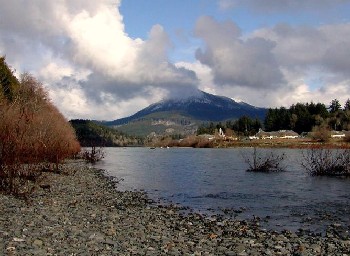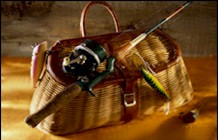The Chetco Wild and Scenic River is divided into three segments: a 27.5-mile
wild segment from the headwaters down to Mislatnah Creek; a 7.5-mile scenic
segment from Mislatnah Creek down to Eagle Creek; and a 9.5-mile recreational
segment from Eagle Creek down to the Siskiyou National Forest boundary.

The Chetco heads in steep, deeply dissected, sparsely vegetated, mountainous
terrain within the Kalmiopsis Wilderness. Over its 55.5 mile length, the Chetco
drops from 3700 feet to sea-level as it empties into the Pacific Ocean between
the towns of Brookings and Harbor, about 5 miles north of the California border.
In the upper section, the river floor is fairly narrow and boulder-strewn with
numerous falls and rapids. As the river leaves the wilderness, its character
gradually changes. The country becomes less dissected, the river gradient
gradually becomes less steep, the river bottom widens, and the surrounding hills
become more densely forested. The river narrows in several areas, crossing
through rock outcrops and leaving enormous boulders in the riverbed. The Chetco
River Gorge, just below Steel Bridge, contains steep sides and unusual rock
formations. Below this, the Chetco continues to broaden, and the gradient
becomes less steep, with sand and gravel bars and raised river terraces becoming
more common.
Fishing the Chetco: The Chetco River fishery, typical of Pacific coastal systems, is dominated by
trout and salmon. There are important populations of anadromous winter
steelhead, fall chinook salmon, and sea-run cutthroat trout. Coho and chum
salmon are occasionally observed. Resident cutthroat and rainbow trout are
abundant in upper stream reaches. Native populations of fall chinook and winter
steelhead are supplemented with hatchery fish. The Chetco provides excellent
spawning and rearing habitat and has some of the highest salmonid smolt returns
of any coastal stream in Oregon. Pacific lamprey, three-spined stickleback, and
assorted sculpin are also known to inhabit this system.
Recreational
Opportunities: Primary transportation routes within the river corridor are the North Bank
Chetco River Road (#1376), the South Bank River Road (#1205), and associated
spur roads. Recreationists can access the recreational and scenic river segments
and launch boats in several locations, including Miller, Nook, Redwood
riverbars; upper and lower South Fork Camps; the Low-water Bridge Site; Forest
Road #1917-067; and the dispersed campsite at Steel Bridge. Various trails
access the river, both maintained and unmaintained. Maintained trails include
the Chetco Gorge Trail (#1112) in the recreational segment and the Tincup Trail
(#1117) in the scenic segment. Access to the wild segment can be accomplished by
trail within the Kalmiopsis Wilderness. The Chetco River at the Slide Creek
confluence is accessible from the eastside of the wilderness via the Upper
Chetco Trail (#1102), southwest of Chetco Pass. The Taggart's Bar area of the
Chetco can be accessed by a combination of the Johnson Butte (#1110) and Upper
Chetco (#1102) trails. These trails are listed as 'most difficult' and are open
to hiking, riding and packstock. For basic trail information and directions to
the trailheads, please refer to theTrail Recreation Opportunity Guide which is
available from the Chetco Ranger District. Or visit the Recreation Opportunities
section of the Siskiyou National Forest Web Page.
Fishing and Boating. Permits are required to float the Chetco for all
users year round. The primary fishing season for steelhead and salmon is
sometime between November and March. Free self-issuing permits are available at
a station along the North Bank Chetco River Road (#1376). Commercial outfitting
for fishing has been established by 40 guides, and all available permits have
been issued at this time. Non-commercial use is not limited but must be
permitted. Motorized boat use is not allowed on any river segment. Off-highway
vehicle crossings of the river are prohibited.
Whitewater boating on the Chetco is restricted by its limited access, high
use during the fishing season, and availability of other good boating
opportunities in the area. A very limited number of kayakers have floated
through the wild segment of the Chetco during high-flow conditions. Rapids are
class III and below during the summer months during average flows. During the
winter months rapid class is higher depending upon flow conditions. Summer
floating during low water conditions has become an increasingly popular river
activity on all river segments. A commercial outfitter/guide service on wild,
scenic and recreation segments, during these low flow conditions, will be in
operation sometime during the 1997 season.
Camping. Day use of river bars and boat launch sites is free. Fees are
required for overnight use (between the hours of 8 pm and 8 am) at Nook and
Redwood Riverbars ($3.00 fee) and the Little Redwood Campground ($6.00 fee). A
camping fee is also required at Loeb State Park located below the Siskiyou
National Forest boundary.
River Ethics. When camping on remote sites without facilities, use
exisitng fire-rings. If a fire-ring is not present, contain your fire using a
fire pan. Pack out all garbage and unburned fire residue. Whenever possible, if
a toilet facility is not available, pack out human fecal waste using a
wilderness toilet system designed to meet state requirements (no use of plastic
bags and provide for discharge into a recreational vehicle dump site). If you
don't have a satisfactory pack-out toilet, bury the waste above the high-water
mark, in mineral soil (not sand), 6"- 8" deep, above the high water mark.
Wilderness Use. Permits are not required for the Kalmiopsis Wilderness
(although a permit must be obtained for floating the Chetco River. The Forest
Service appreciates your filling out our voluntary registration cards at the
trailheads. Wilderness and wild and scenic river corridors are sensitive
environments which require the practice of the best Leave No Trace ethics in
minimizing impacts while still enjoying these natural areas. Information about
the Leave No Trace program is available from the Forest Service, at the Leave No Trace Home
Page, or by calling 1-800-332-4100.





